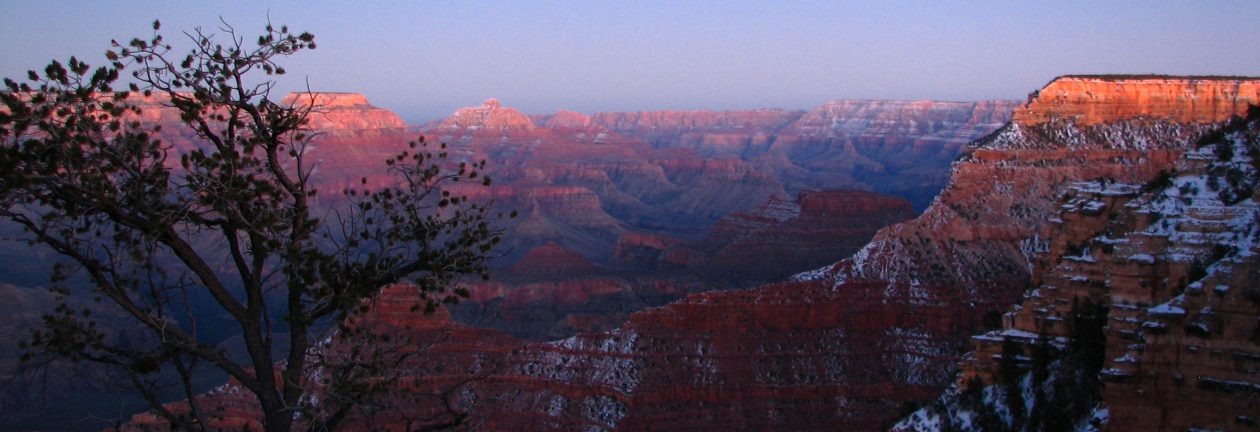Yogyakarta, Indonesia
Today my mission was to see the Borobudur temple complex (or “Candi Borobudur”), a 9th-century AD Mahayana Buddhist temple and the largest Buddhist temple in the world. I got ready and then walked to the city bus stop on Malioboro street. From there I took one bus and then transferred to another in order to get to the city bus terminal located to the northwest of Yogyakarta. At the bus terminal I then took the cheapest bus north to Borobudur, which was about a ninety minute drive. Upon reaching the final destination, I ignored the touts offering me expensive rides on their motorbikes and horse drawn carriages and walked for about five minutes before reaching the entrance to the temple compound. I then paid the expensive foreigner entrance fee (230,000 rupiahs non-Indonesians as opposed to 30,000 rupiahs for Indonesians), had a sarong put on me to cover my modest long pants, enjoyed my complimentary coffee, and then walked off to see the towering temple.
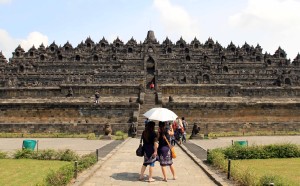
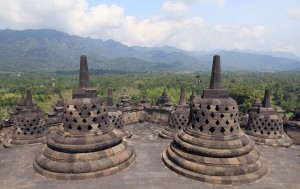
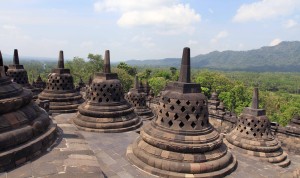
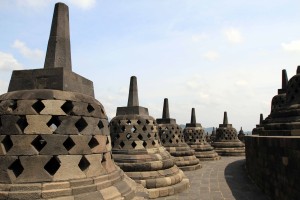
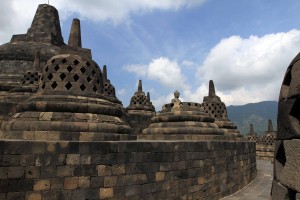
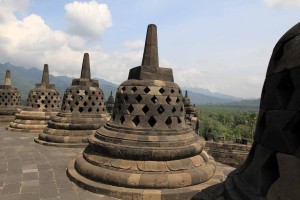
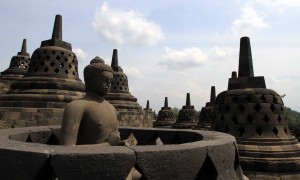
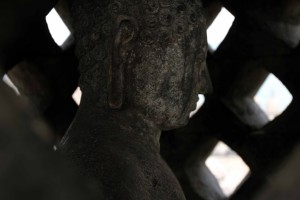
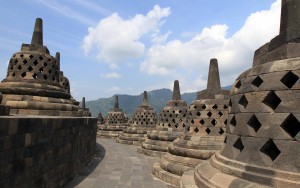
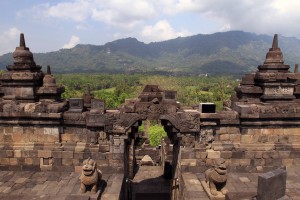
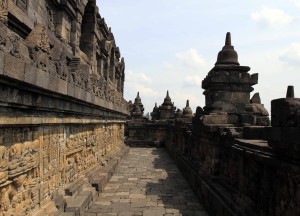
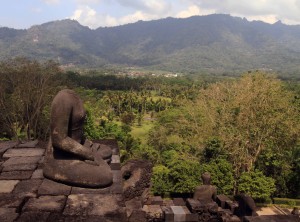
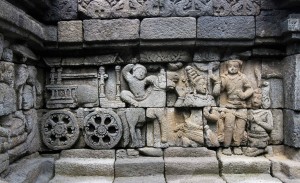
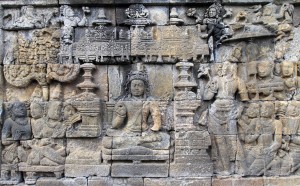
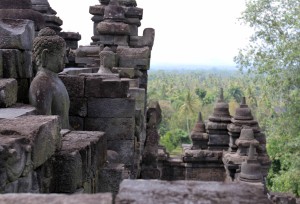
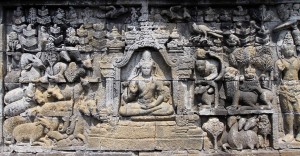
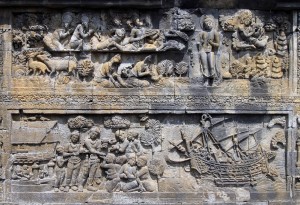
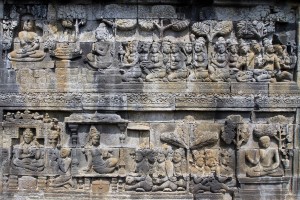
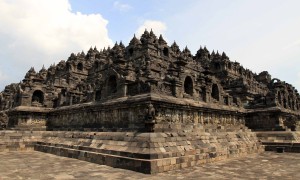
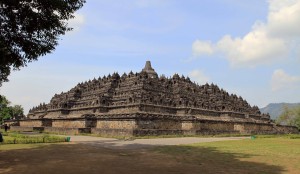
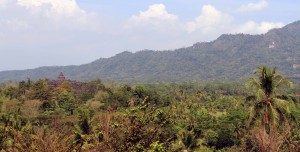
The temple consists of six square platforms or tiers with three circular platforms on top. The six tiers are decorated with 2,672 relief panels and 504 Buddha statues; the three circular platforms have 72 perforated stupas with Buddha statues in each one, and they surround a giant dome at the very top and center of the temple. As tourists and pilgrims ascend to the top of the temple, they pass through three symbolic levels of Buddhist cosmology: Kāmadhātu (the world of desire), Rupadhatu (the world of forms) and Arupadhatu (the world of formlessness); each level is represented by the various relief panels found along the six bottom tiers. I first climbed up to the top of the structure and then walked around the top three platforms trying to get as many photos as I could free from other tourists (I ended up visiting around high noon, so luckily there were not too many crowds of people thanks to the glaring sun and heat). I also admired the surrounding location with green mountains and jungles in the distance. After spending a considerable amount of time at the top of the temple, I then began my descent down through the three symbolic levels. I walked around each bottom tier looking at all the reliefs – though I made sure to spend more time in what little shade there was before quickly passing through the sun-filled sections. Along the walls of each tier, there were the Buddha statues sitting peacefully, looking out away from the temple; although not every thousand-plus year old statue was complete and many were missing their heads. After completely walking around each platform and tier of the temple, I finally reached the bottom again. Before leaving the site of the temple, I walked to an open field near the exit where I was given a grand view of the massive stone structure. I then exited the temple grounds, passing by many vendors lined up along the pathway trying to sell overpriced water and souvenirs, and walked to the two museums in the park. The first one was about ancient Indonesian maritime ships, many of which were depicted on the 9th-century AD relief panels at Borobudur; there was also a recreation of one of the ancient ships that a modern Australian explorer and crew used to travel from Indonesia to Madagascar to prove that it could be done. I then walked to the second museum which showcased the history of Borobudur from construction to restoration, after it had been “discovered” by Sir Thomas Stamford Raffles, a British statesman during Great Britain’s short colonial rule of Java (1811-1816). After having been abandoned since the 1400s, the temple was in a state of disrepair and – like many other ancient monuments – it had been pillaged for other local construction projects. In the beginning of the 20th-century, the first restoration of the temple occurred and it was followed by several more until the temple was completed, as seen today. After spending some time in these two museums, sheltered from the sun, I went back outside and then hiked up to Bukit Dagi (a nearby hill) to see if I could get a better view of the temple; however, due to thick vegetation, all I could see was the top of the temple, also it was too distant for my camera lens – with its modest zooming abilities – to see any great detail of the temple. So I walked back down the hill and then exited the park to see the two temples located in a straight-line, east of Borobudur.
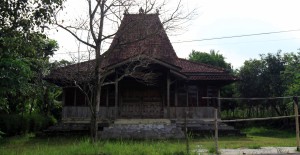
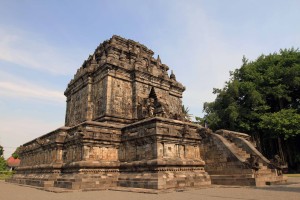
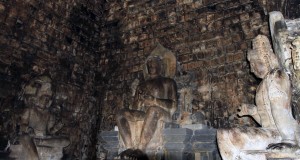
I followed the road that leads back to Yogyakarta, passing by a number of traditional-styled Indonesian homes, and walked about three kilometers before reaching Candi Mendut, another Buddhist temple that is believed to have served as a way point for pilgrims journeying to Borobudur. Inside the chamber of Candi Mendut, sits three Buddha statues and, while I was there, several Western tourists meditating. Compared to the grand scale of Borobudur, Candi Mendut is much smaller, with its one chamber and one platform lined with relief panels. Upon exiting the temple site, a vendor tried to sell me a t-shirt; I tried my best to politely decline her offer and to explain to her that I was not buying any souvenirs on my planned fifteen-month travel, but she was persistent and I listened to her start at a price of 40,000 rupiahs which was then eventually lowered down to 20,000 rupiahs before she finally gave up. So apparently the best way to get the best price without wasting breath haggling is just to just pretend you’re not interested in buying anything.
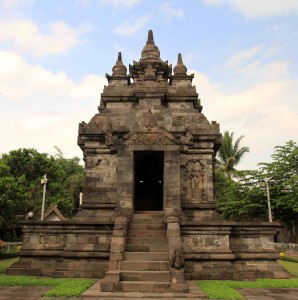
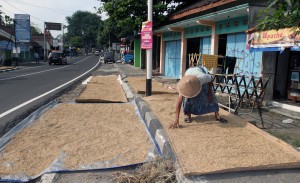
From Candi Mendut, I headed back toward Borobudur for about one kilometer before finding the road to Candi Pawon, an even smaller Buddhist temple than Candi Mendut. It also had a small chamber you can enter and reliefs along the one platform the temple chamber sits on. After my visit to Candi Pawon, I walked back to the bus station and took the next bus back to Yogyakarta. Once we reached the bus terminal in Yogyakarta, I took the city bus back to Malioboro Street. Along the ride to Malioboro, I saw a bunch of youths trying to change the world by standing on a street corner in Yogyakarta waving Palestinian flags and holding up banners for “S.O.S. Palestine”; personally, I’m not so certain that the world can change, at least not without a drastic change made to human nature, but then, of course, we would no longer be human (at least not in the classical sense); although I am certain that naively standing on a street corner and protesting will change nothing in the world, nor will it affect a change in anyone’s mind, which has already been made up on the issue; it may rouse anger in simple-minded supporters, which may lead to more violence like in Europe, thus making a protest for peace in to one of violence, and (unfortunately . . .) many of the stupid people protesting will completely miss the comical irony of such a turn, they will not reflect on the past nor think of a better way to proceed in the future, and they will continue to be themselves – thus changing nothing.
Anyway, after reaching Malioboro Street, I went to the same garden-terrace restaurant that I ate at the night before, where I had chicken, lamb, and beef satay with white rice and beer. I then went back to the guesthouse I was staying at, grew frustrated with the slow internet connection, and then eventually went to sleep.
